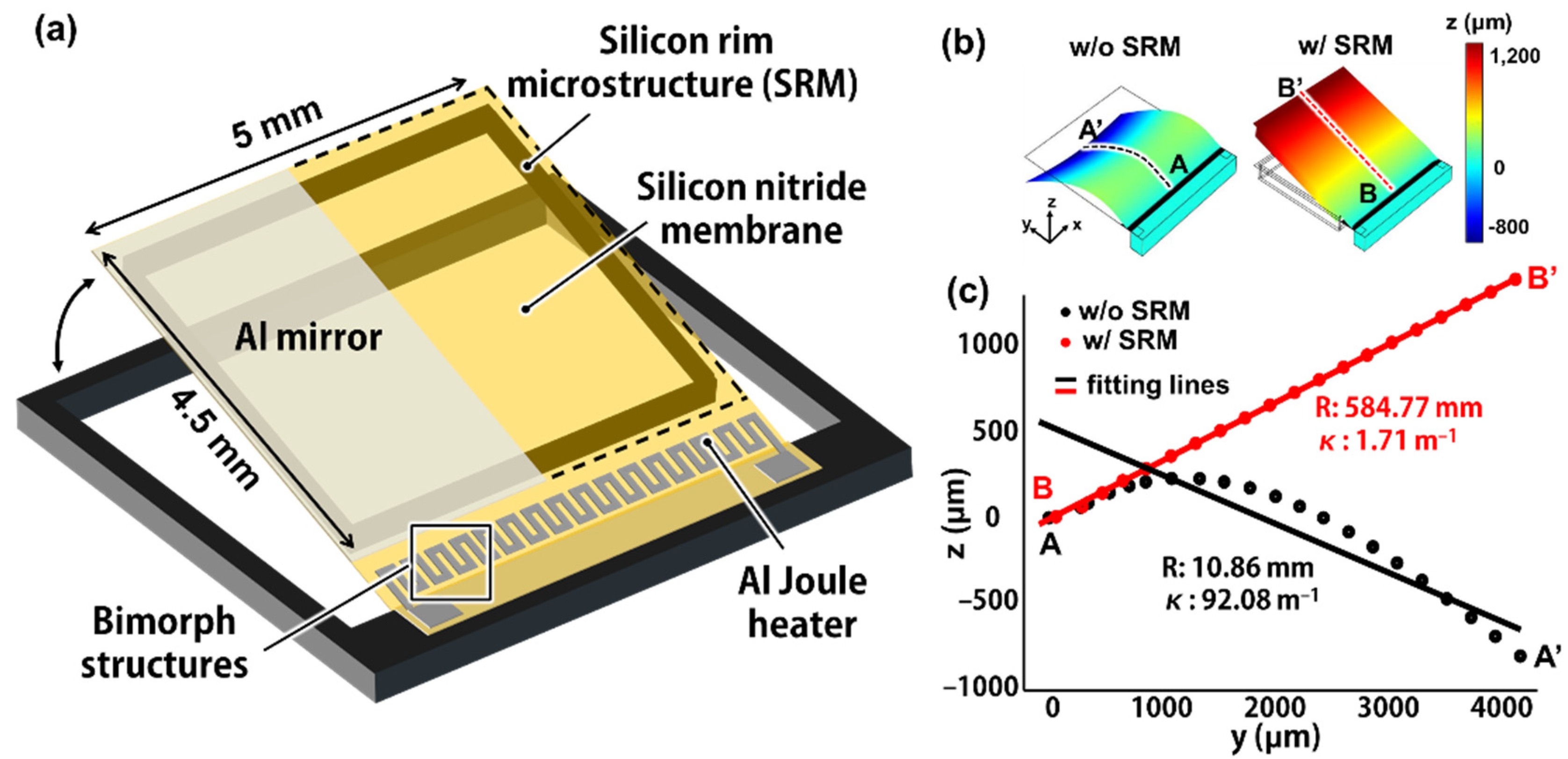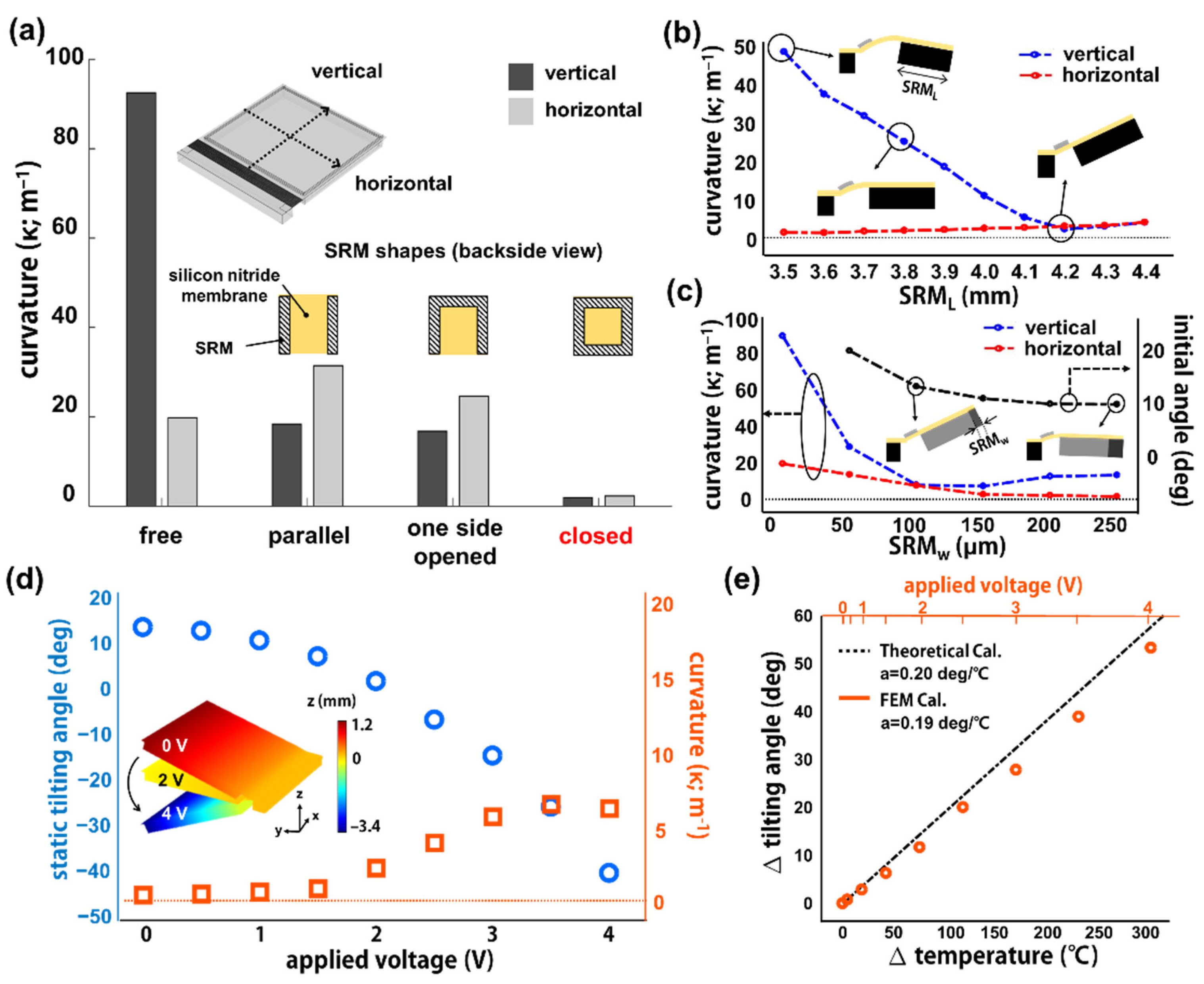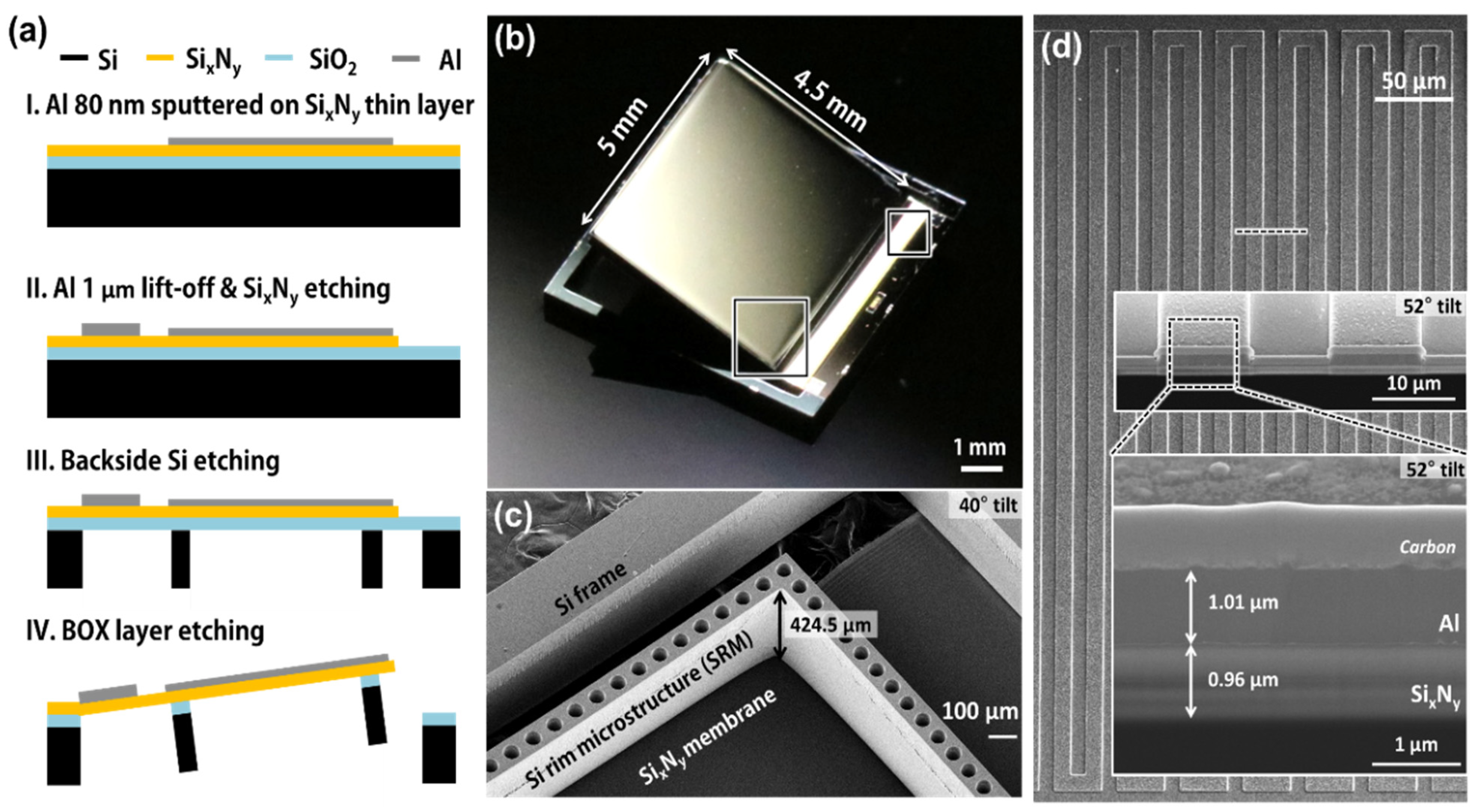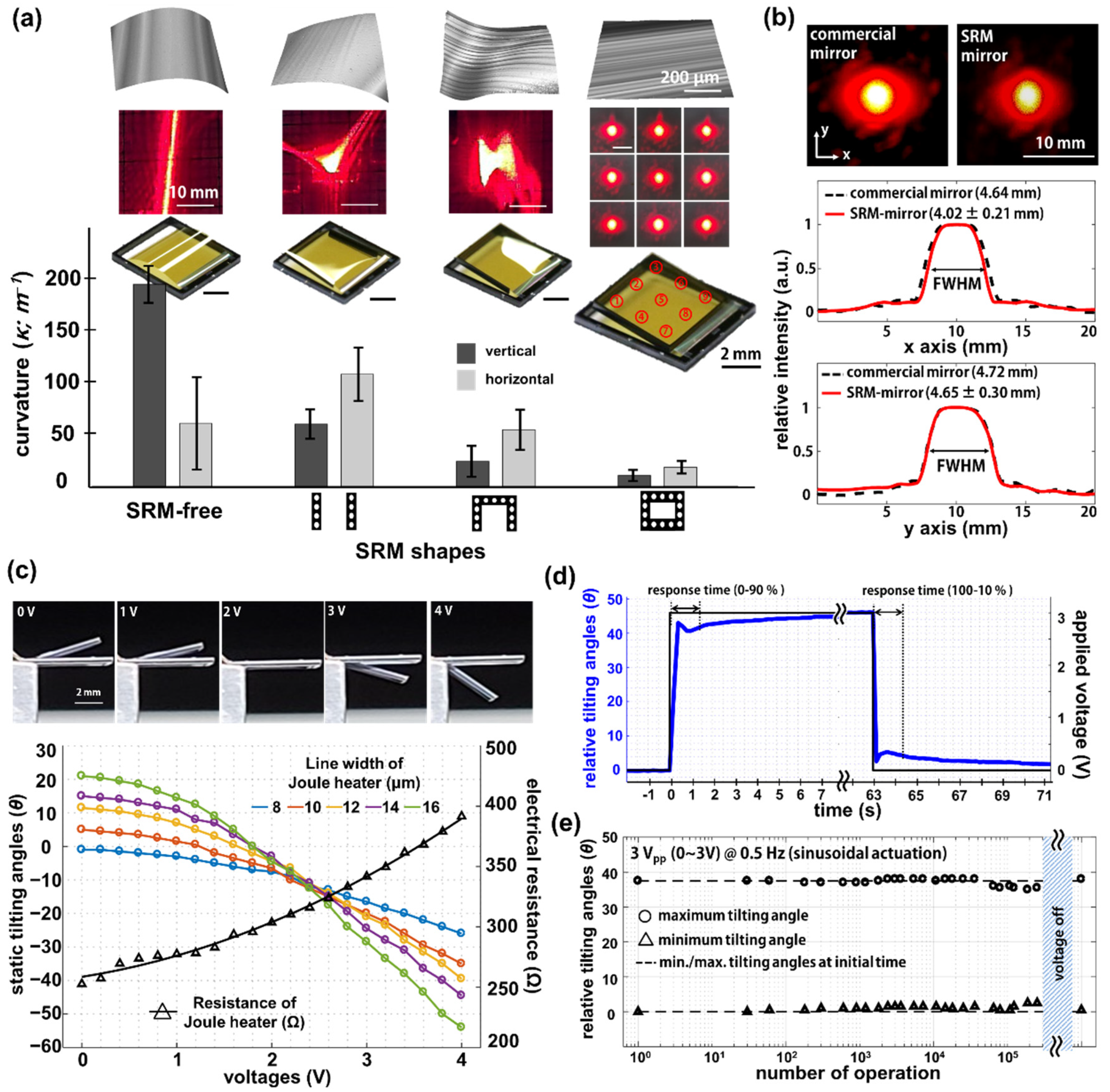Large-Area and Ultrathin MEMS Mirror Using Silicon Micro Rim
Abstract
:1. Introduction
2. Design and Parameters of SRM-Mirror
2.1. SRM-Mirror
2.2. Design Parameters
3. Microfabrication of SRM-Mirror
4. Mechanical and Optical Characterization of SRM-Mirror
5. Conclusions
Supplementary Materials
Author Contributions
Funding
Data Availability Statement
Conflicts of Interest
References
- Bifano, T. Adaptive imaging MEMS deformable mirrors. Nat. Photonics 2011, 5, 21–23. [Google Scholar] [CrossRef]
- Kim, H.; Seo, Y.H.; Jeon, J.; Jeong, K.H. Lissajous scanning structured illumination microscopy. Biomed. Opt. Express 2020, 11, 5575–5585. [Google Scholar] [CrossRef] [PubMed]
- Sandner, T.; Kenda, A.; Drabe, C.; Schenk, H.; Scherf, W. Miniaturized FTIR-Spectrometer based on optical MEMS translatory actuator. MOEMS Miniat. Syst. VI 2007, 6466. [Google Scholar] [CrossRef]
- Chen, L.; Chen, Y.K. Compact, low-loss and low-power 8 × 8 broadband silicon optical switch. Opt. Express 2012, 20, 18977–18985. [Google Scholar] [CrossRef] [PubMed]
- Hornbeck, L.J. The DMD (TM) projection display chip: A MEMS-based technology. MRS Bull. 2001, 26, 325–327. [Google Scholar] [CrossRef]
- Yalcinkaya, A.D.; Urey, H.; Brown, D.; Montague, T.; Sprague, R. Two-axis electromagnetic microscanner for high resolution displays. J. Microelectromech. Syst. 2006, 15, 786–794. [Google Scholar] [CrossRef]
- Seo, Y.H.; Kim, H.; Yang, S.P.; Hwang, K.; Jeong, K.H. Lissajous scanned variable structured illumination for dynamic stereo depth map. Opt. Express 2020, 28, 15173–15180. [Google Scholar] [CrossRef] [PubMed]
- Tanguy, Q.A.A.; Bargiel, S.; Xie, H.K.; Passilly, N.; Barthes, M.; Gaiffe, O.; Rutkowski, J.; Lutz, P.; Gorecki, C. Design and Fabrication of a 2-Axis Electrothermal MEMS Micro-Scanner for Optical Coherence Tomography. Micromachines 2017, 8, 146. [Google Scholar] [CrossRef]
- Li, F.Y.; Zhou, P.; Wang, T.T.; He, J.H.; Yu, H.J.; Shen, W.J. A Large-Size MEMS Scanning Mirror for Speckle Reduction Application. Micromachines 2017, 8, 140. [Google Scholar] [CrossRef] [Green Version]
- Hofmann, U.; Aikio, M.; Janes, J.; Senger, F.; Stenchly, V.; Hagge, J.; Quenzer, H.J.; Weiss, M.; von Wantoch, T.; Mallas, C.; et al. Resonant biaxial 7-mm MEMS mirror for omnidirectional scanning. J. Micro-Nanolith. Mem. 2014, 13, 1103. [Google Scholar] [CrossRef]
- Koh, K.H.; Lee, C. A Two-Dimensional MEMS Scanning Mirror Using Hybrid Actuation Mechanisms with Low Operation Voltage. J. Microelectromech. Syst. 2012, 21, 1124–1135. [Google Scholar] [CrossRef]
- Fan, K.C.; Lin, W.L.; Chiang, L.H.; Chen, S.H.; Chung, T.T.; Yang, Y.J. A 2 × 2 Mechanical Optical Switch with a Thin MEMS Mirror. J. Lightwave Technol. 2009, 27, 1155–1161. [Google Scholar] [CrossRef]
- Zhang, C.; Giroux, M.; Nour, T.A.; St-Gelais, R. Radiative Heat Transfer in Freestanding Silicon Nitride Membranes. Phys. Rev. Appl. 2020, 14. [Google Scholar] [CrossRef]
- Jang, K.W.; Yang, S.P.; Baek, S.H.; Lee, M.S.; Park, H.C.; Seo, Y.H.; Kim, M.H.; Jeong, K.H. Electrothermal MEMS parallel plate rotation for single-imager stereoscopic endoscopes. Opt. Express 2016, 24, 9667–9672. [Google Scholar] [CrossRef] [PubMed] [Green Version]
- Peng, W.Y.; Xiao, Z.X.; Farmer, K.R. Optimization of thermally actuated bimorph cantilevers for maximum deflection. Nanotech. Proc. 2003, 1, 376–379. [Google Scholar]
- Yu, S.J.; Li, S.C.; Ni, Y.; Zhou, H. Size dependent morphologies of brittle silicon nitride thin films with combined buckling and cracking. Acta Mater. 2017, 127, 220–229. [Google Scholar] [CrossRef]
- Marthelot, J.; Roman, B.; Bico, J.; Teisseire, J.; Dalmas, D.; Melo, F. Self-Replicating Cracks: A Collaborative Fracture Mode in Thin Films. Phys. Rev. Lett. 2014, 113. [Google Scholar] [CrossRef] [Green Version]
- Ghaderi, M.; Ayerden, N.P.; de Graaf, G.; Wolffenbuttel, R.F. Minimizing stress in large-area surface micromachined perforated membranes with slits. J. Micromech. Microeng. 2015, 25. [Google Scholar] [CrossRef]
- Faou, J.Y.; Parry, G.; Grachev, S.; Barthel, E. Telephone cord buckles-A relation between wavelength and adhesion. J. Mech. Phys. Solids 2015, 75, 93–103. [Google Scholar] [CrossRef] [Green Version]
- Stoney, G.G. The tension of metallic films deposited by electrolysis. In Proceedings of the Royal Society of London. Series A, Containing Papers of A Mathematical and Physical Character; Royal Society: London, UK, 1909; Volume 82, pp. 172–175. [Google Scholar] [CrossRef] [Green Version]
- Noskov, A.G.; Gorokhov, E.B.; Sokolova, G.A.; Trukhanov, E.M.; Stenin, S.I. Correlation between Stress and Structure in Chemically Vapor-Deposited Silicon-Nitride Films. Thin Solid Films 1988, 162, 129–143. [Google Scholar] [CrossRef]
- Kaushik, A.; Kahn, H.; Heuer, A.H. Wafer-level mechanical characterization of silicon nitride MEMS. J. Microelectromech. Syst. 2005, 14, 359–367. [Google Scholar] [CrossRef]
- Yang, J.L.; Gaspar, J.; Paul, O. Fracture Properties of LPCVD Silicon Nitride and Thermally Grown Silicon Oxide Thin Films from the Load-Deflection of Long Si3N4 and SiO2/Si3N4 Diaphragms. J. Microelectromech. Syst. 2008, 17, 1120–1134. [Google Scholar] [CrossRef]
- Cheng, M.C.; Chang, C.P.; Huang, W.S.; Huang, R.S. Ultralow-stress silicon-rich nitride films for microstructure fabrication. Sens. Mater 1999, 11, 349–358. [Google Scholar] [CrossRef]
- Kandpal, M.; Behera, S.N.; Singh, J.; Palaparthy, V.; Singh, S. Residual stress compensated silicon nitride microcantilever array with integrated poly-Si piezoresistor for gas sensing applications. Microsyst. Technol. 2020, 26, 1379–1385. [Google Scholar] [CrossRef]
- Tanaka, K.; Ishihara, K.; Akiniwa, Y.; Ohta, H. Residual stress of aluminum thin films measured by X-ray and curvature methods. Mater. Sci. Res. Int. 1996, 2, 153–159. [Google Scholar] [CrossRef]
- Jou, J.H.; Chung, C.S. Mechanical Characteristics of Aluminum Thin-Films on Silicon and Gallium-Arsenide. Thin Solid Films 1993, 235, 149–155. [Google Scholar] [CrossRef]
- Zorman, C.A.; Roberts, R.C.; Chen, L. Additive processes for semiconductors and dielectric materials. In MEMS Materials and Processes Handbook; Springer: Boston, MA, USA, 2011; pp. 37–136. [Google Scholar]
- Sharma, N.; Hooda, M.; Sharma, S.K. Stresses in thin films: An experimental study. Indian J. Phys. 2019, 93, 159–167. [Google Scholar] [CrossRef]




| Parameters | Values | Remark |
|---|---|---|
| Geometric | ||
| SixNy membrane area | 5 mm (w) × 4.5 mm (l) | |
| SixNy membrane thickness | 1 μm | Figure S2a |
| SiO2 thickness | 1.5 μm | |
| Al mirror thickness | 80 nm | Figure S2b |
| Al heater (line pattern) thickness | 1 μm | Figure S2a |
| Al heater (line pattern) length | 500 μm | |
| Al heater (line pattern) width | 14 μm | |
| Al heater (line pattern) pitch | 20 μm | |
| SRM length (horizontal/vertical) | 4.9 mm/4.2 mm | |
| SRM width | 120 μm | |
| Silicon frame (outmost) | 6 mm (w) × 6 mm (l) | |
| Mechanical | ||
| CTE of Al | 23.1 × 10−6 [K−1] g | |
| CTE of SixNy | 2.3 × 10−6 [K−1] g | |
| CTE of SiO2 | 0.55 × 10−6 [K−1] g | |
| Thermal Conductivity of Al | 237 [W/(K·m)] g | |
| Thermal Conductivity of SixNy | 20 [W/(K·m)] g | |
| Thermal Conductivity of SiO2 | 1.38 [W/(K·m)] g | |
| Residual stress of Al | 200 [MPa] | [26,27] |
| Residual stress of SixNy | 100 [MPa] | [28,29] |
| Elastic Modulus of Al | 70 [GPa] g | |
| Elastic Modulus of SixNy | 200 [GPa] | [28] |
| Poisson Ratio of Al | 0.35 [a.u.] g | |
| Poisson Ratio of SixNy | 0.23 [a.u.] g |
Publisher’s Note: MDPI stays neutral with regard to jurisdictional claims in published maps and institutional affiliations. |
© 2021 by the authors. Licensee MDPI, Basel, Switzerland. This article is an open access article distributed under the terms and conditions of the Creative Commons Attribution (CC BY) license (https://creativecommons.org/licenses/by/4.0/).
Share and Cite
Ahn, M.-S.; Jeon, J.; Jang, K.-W.; Jeong, K.-H. Large-Area and Ultrathin MEMS Mirror Using Silicon Micro Rim. Micromachines 2021, 12, 754. https://doi.org/10.3390/mi12070754
Ahn M-S, Jeon J, Jang K-W, Jeong K-H. Large-Area and Ultrathin MEMS Mirror Using Silicon Micro Rim. Micromachines. 2021; 12(7):754. https://doi.org/10.3390/mi12070754
Chicago/Turabian StyleAhn, Myeong-Su, Jaehun Jeon, Kyung-Won Jang, and Ki-Hun Jeong. 2021. "Large-Area and Ultrathin MEMS Mirror Using Silicon Micro Rim" Micromachines 12, no. 7: 754. https://doi.org/10.3390/mi12070754
APA StyleAhn, M.-S., Jeon, J., Jang, K.-W., & Jeong, K.-H. (2021). Large-Area and Ultrathin MEMS Mirror Using Silicon Micro Rim. Micromachines, 12(7), 754. https://doi.org/10.3390/mi12070754








